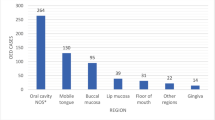Abstract
The objective of this study is to identify a management or follow-up strategy for patients with laryngeal and oral dysplasia. A chart review of all patients with laryngeal and oral dysplasia over a 15-year period was performed. All patients were followed for a minimum period of 5 years from initial diagnosis of oropharyngeal or laryngeal dysplasia. If invasive carcinoma was demonstrated on subsequent biopsies, the exact time of this was recorded and Kaplan–Meier survival curves were plotted. In the laryngeal cohort, 45 patients were identified, 15 (33%) developed carcinoma, 7 of 30 patients (23%) with mild or moderate dysplasia, compared with 8 of 15 (53%) with severe dysplasia or CIS (P = 0.01). Thirteen of the carcinomas (87%) developed within 36 months of original biopsy. In the oral cohort, 32 patients were identified, 17 (53%) developed carcinoma, 1 of 9 patients (11%) with mild dysplasia, compared with 8 of 12 (67%) with severe dysplasia and 8 of 10 (80%) with CIS (P < 0.001). Fifteen of the 17 patients (88%) developed carcinoma within 36 months of original biopsy. In conclusion, although numbers are small, our results show that mild and moderate laryngeal dysplasia behaves differently to severe dysplasia and CIS. Mild oral dysplasia also behaves differently to severe dysplasia or CIS. In general, progress to malignancy happens within a 3-year period. Severe dysplasia or CIS should be managed aggressively.





Similar content being viewed by others
References
Staibano S, Merolla F, Testa D et al (2007) OPN/CD44v6 over-expression in laryngeal dysplasia and correlation with clinical outcome. Br J Cancer 97(11):1545–1551. doi:10.1038/sj.bjc.6604070
Sadri M, McMahon J, Parker A (2006) Laryngeal dysplasia: aetiology and molecular biology. J Laryngol Otol 120:170–177. doi:10.1017/S0022215105005360
Arens C, Glanz H, Dreyer T, Malzahn K (2003) Compact endoscopy of the larynx. Ann Otol Rhinol Laryngol 112(2):113–119
Lee JJ, Hong WK, Hittelman WM et al (2000) Predicting cancer development in oral leukoplakia: ten years of translational research clinical cancer research 6:1702–1710
Lodi G, Sardella A, Bez C, Demarosi F, Carrassi A (2006) Interventions for treating oral leukoplakia. Cochrane Database Syst Rev Issue 4
Sadri M, McMahon J, Parker A (2006) Management of laryngeal dysplasia: a review. Eur Arch Otorhinolaryngol 263(9):843–852. doi:10.1007/s00405-006-0078-y
Isenberg JS, Crozier DL, Dailey SH (2008) Institutional and comprehensive review of laryngeal leukoplakia. Ann Otol Rhinol Laryngol 117(1):74–79
Steiner W, Ambrosch P (2000) Endoscopic laser surgery of the upper aerodigestive tract: special emphasis on cancer surgery. Thieme, Berlin
Dey P, Arnold D, Wight R, MacKenzie K, Kelly C (2002) Radiotherapy versus open surgery versus endolaryngeal surgery (with or without laser) for early laryngeal squamous cell cancer. Cochrane Database Syst Rev Issue 2
Reichart PA, Philipsen HP (2005) Oral erythroplakia—a review. Oral Oncol 41:551–561. doi:10.1016/j.oraloncology.2004.12.003
Ishii J, Fujita K, Komori T (2003) Laser Surgery as a treatment for oral leukoplakia. Oral Oncol 39:759–769. doi:10.1016/S1368-8375(03)00043-5
Van der Hem PS, Nauta JM, Van der Wal JE, Roodenburg JLN (2005) The results of CO2 laser surgery in patients with oral leukoplakia: a 35 year follow up. Oral Oncol 41:31–37. doi:10.1016/j.oraloncology.2004.06.010
Pandey M, Thomas G, Somanathan T et al (2001) Evaluation of surgical excision of non-homogenous oral leukoplakia in a screening intervention trial, Kerala, India. Oral Oncol 37:103–109. doi:10.1016/S1368-8375(00)00070-1
Marley JJ, Cown CG, Lamey P-J et al (1996) Management of potentially malignant oral mucosal lesions by consultant UK oral and maxillofacial surgeons. Br J Oral Maxillofac Surg 34:28–36. doi:10.1016/S0266-4356(96)90132-1
Conflict of interest statement
The authors do not have anything to disclose. No financial support was given and there are no conflicts of interest.
Author information
Authors and Affiliations
Corresponding author
Rights and permissions
About this article
Cite this article
Spielmann, P.M., Palmer, T. & McClymont, L. 15-Year review of laryngeal and oral dysplasias and progression to invasive carcinoma. Eur Arch Otorhinolaryngol 267, 423–427 (2010). https://doi.org/10.1007/s00405-009-1013-9
Received:
Accepted:
Published:
Issue Date:
DOI: https://doi.org/10.1007/s00405-009-1013-9



